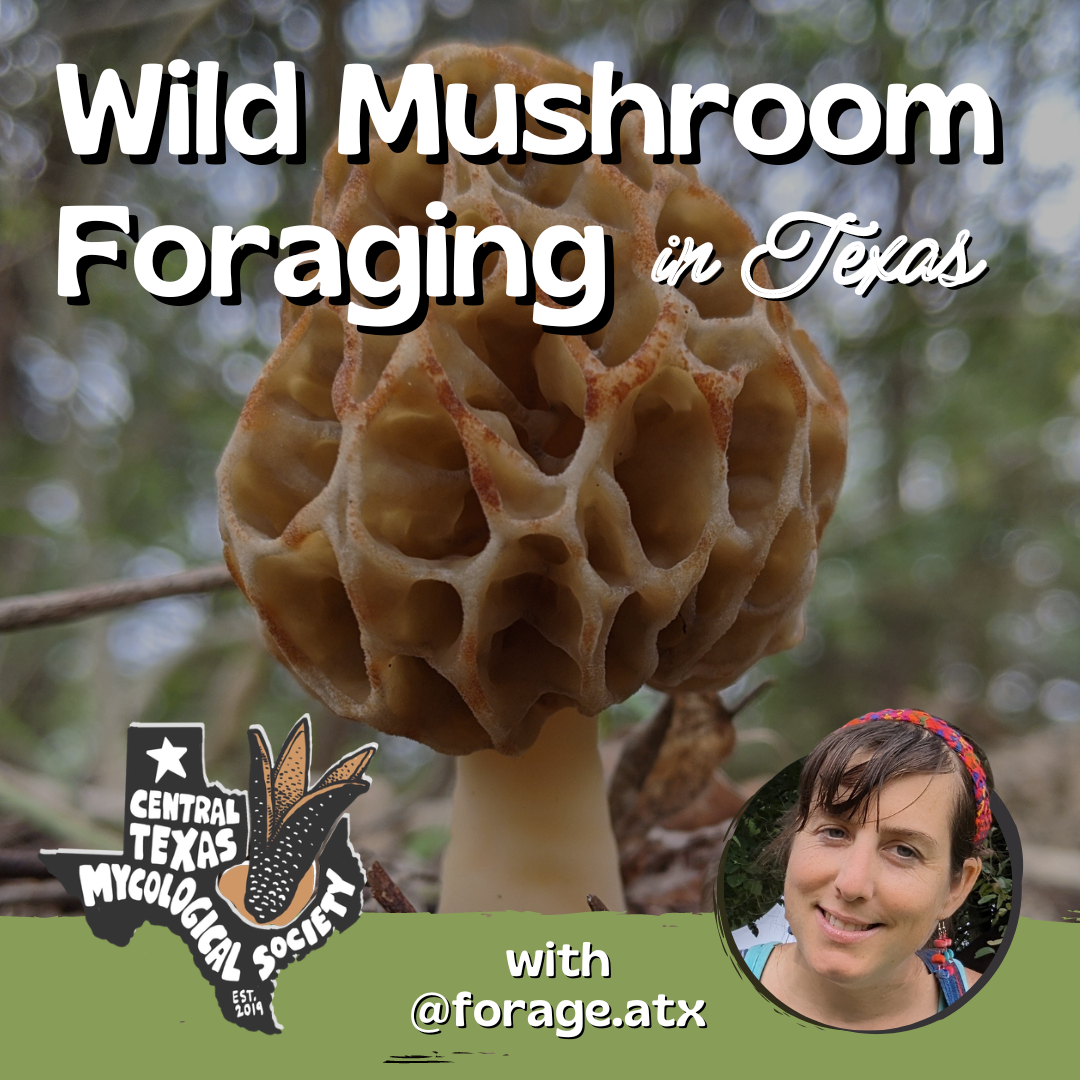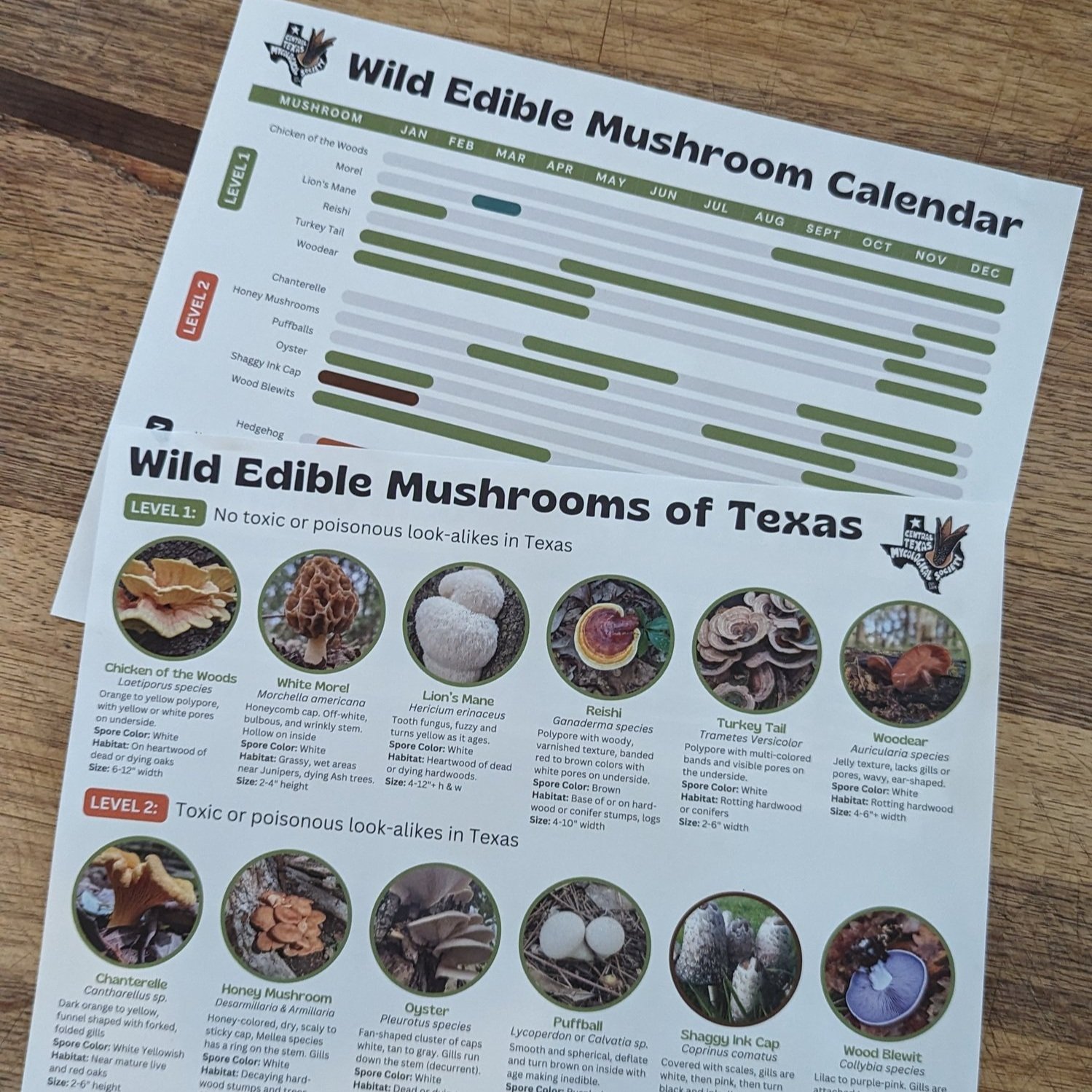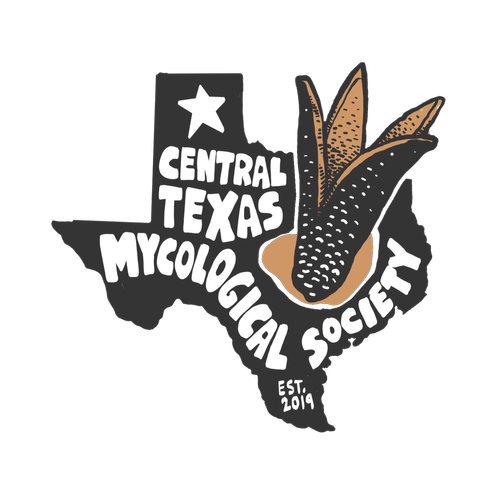Learn wild, edible mushrooms fruiting in Texas after rain.
Comes with download of a Wild Edible Mushroom Calendar.


Wood Blewit Collybia species, formerly Lepista, Clitocybe
Description: Lilac to purple-pink. Gills are attached to short, stout stem with bulbous base.
Habitat: Grows in and decomposes leaf duff
Size: 3-6" cap diamter Spore Color: Light pink to white
Edibility: Good. Try in breakfast tacos
Look-alikes: Purple webcaps in the Cortinarius genus can be toxic and grow in same habitat. Spore print is rust colored.
Lion’s Mane, Hericium erinaceus
Lion’s mane is a choice edible mushroom that rarely grows in the wild in Central Texas. I have foraged it a few times and it fruits on the cankers of post oaks in Central Texas. It is more abundant in East Texas on decaying oaks.
DESCRIPTION: Tooth fungus, fuzzy and turns yellow as it ages.
HABITAT: Fruits on decomposing hardwood or heartwood or cankers of living post oak in the winter after rain. SPORE COLOR: White
SIZE: 4-12"+ h & w
EDIBILITY: Mildly sweet flavor, tender texture that mimics shellfish like scallops, crab, or lobster. Medicinal
LOOK A-LIKE: Hericium americanum, Bear's Head Tooth & Hericium Coralloides, Coral Tooth (Edible). Marshmallow polypore, Irpiciporus pachyodon (Inedible)
MEDICINAL BENEFITS
Not only does this mushroom taste delicious, it’s good for you. Lion’s mane mushrooms contain bioactive substances that have beneficial effects on the body, especially the brain, heart and gut. Scientific studies have found this mushroom may:
✨ Reduce Inflammation
✨ Relieve Depression and Anxiety
✨ Protect against dementia and Alzheimer's
✨ Protect Against Ulcers in the Digestive Tract
✨ Reduce Heart Disease Risk
✨ Help Manage Diabetes Symptoms
✨ Cancer Fighting Properties
Where to Buy
It is also cultivated by several local mushroom farms and available at farmers markets and groceries stores. You can also pick them up at various locations in Central Texas with our mushroom block giveaway program and get a second fruiting in the cool winter months.
Hi-Fi Myco and Cap City Shrooms at farmers markets and Central Market
SmallHold at Central Market, Whole Foods
Go here for a complete list of Texas mushroom companies.
OYSTER: Pleurotus ostreatus
DESCRIPTION: Color can vary white, tan and gray.White to cream gills, run down stem.
HABITAT: Grows in clusters and decomposes hardwood.
SPORE COLOR: White
SIZE: Cap fan shaped, 2"-8" across.
EDIBILITY: Choice. Delicious meat replacement in all types of cuisines
LOOK A-LIKE: The Southern Jack-o-lantern, Omphalotus subilludens is the toxic look-a-like and is orange to brown in color. They do grow at the same time but their habitat and morphology is different.
Chicken of the Woods: Laetiporus, 4 species in texas
Description: Orange to yellow polypore, with yellow or white pores on underside.
Habitat: Grows in shelfs on heartwood of dead or dying oaks.
Spore Color: White Size: 6-12" width
Edibility: Contains proteins, fat, fiber and tastes just like chicken! Harvest when young, colorful, and moist. Becomes lighter in color, fiborus, mealy and dry, inedible with age.
Look-alikes: Shaggy Bracket, Inonotus hispidus (non-toxic)
Ringless Honey Mushroom: Desarmillaria & ArmillariA Species
Ringless Honey Mushroom, Desarmillaria caespitosa will start been popping up all over Austin in large clusters at the bases of trees (when the clusters appear to be terrestrial they are actually growing from underground wood) in late summer and fall. This parasitic fungus is part of a genus that is the largest living organism ever found on this planet.
Description: Honey-colored, dry, scaly to sticky cap. Mellea species has a ring on the stem. Gills, some species have a ring.
Habitat: Grows in clusters on decaying hard-wood.
Spore Color: White
Size: 6" in Height
Edibility: Not Choice.
Look-alikes: Southern Jack-o-lantern, Omphalotus subilludens which is toxic and orange to brown in color.
REISHI: Ganoderma, 12 species in Texas
DESCRIPTION: Polypore with woody, varnished texture, banded red to brown colors with white pores on underside.
HABITAT: Grows at base or on hardwood stumps, logs, especially oaks and pecan. Pines in East Texas.
SPORE COLOR: Brown
SIZE: 4-10" width
EDIBILITY: Medicinal. Very bitter because of medicinal compounds.
LOOK-ALIKES: Red-Belted Conk, Fomitosis Pinicola (also medicinal).
Witches Butter. Tremella mesenterica
Description: Bright yellow, parasitic jelly fungus
Habitat: Found on angiosperm bark and feeds on wood-decay fungi in the genus Peniophora consuming them as it grows.
Spore Color: White to Yellow Size: up to 3"
Edibility: Edible and flavorless. Studies suggest antitumor, antioxidative, and antiallergenic. Candied witch’s butter, resembling sour gummy candy, is a delightful treat packed with health benefits.
Look a-likes: Golden Ear or Tremella aurantia, Orange jelly or Dacrymyces palmatus and Fan-shaped Jelly Fungus or Dacryopinax spathularia are all edible.
WOOD EAR: Auricularia 6+- species in Texas
DESCRIPTION: Brown to amber in color. Jelly texture that is irregular, wavy, and ear-shaped. Lacks gills or pores.
HABITAT: Grows in clusters on decaying hardwood after rain
SPORE COLOR: White
SIZE: 4-6" in width and > 1/4" thick
EDIBILITY: Wood ear mushrooms are a popular ingredient in many Chinese dishes, such as hot and sour soup, and also used in Chinese medicine. It is also used in Ghana, as a blood tonic. Modern research into possible medical applications has variously concluded that wood ear has anti-tumor, hypoglycemic, anticoagulant and cholesterol-lowering properties.
LOOK-ALIKES: Amber Jelly, Exidia recisa which is also edible.
Puffball: Lycoperdon and Calvatia, 15+- species in Texas
DESCRIPTION: Smooth and spherical, deflate and turn purplish or brown on inside with age making inedible. Some peal and have spines.
HABITAT: Overgrazed Prairie or grasslands.
SPORE COLOR: Purple-brown
SIZE: 2- 60" diameter
EDIBILITY: Doesn’t have a strong flavor of its own and absorb flavors. Try making a Giant Puffball Pizza.
LOOK-ALIKES: Amanita species which can contain toxins and be fatal. If center of puffball is not white, it can cause GI distress.
TURKEY TAIL Trametes versicolor
DESCRIPTION: Variable coloration, distinct striping pattern. No gills, pores are small and round, white to light brown
HABITAT: Grows in overlapping clusters on logs and stumps
SPORE COLOR: White
SIZE: Cap fan shaped, 2"-8" across.
EDIBILITY: Medicinal. Tough, leathery flesh. Can be brewed into a tea, broth, or extracted into a tincture.
LOOK A-LIKE: False turkey tail. or Stereum ostrea and is non-toxic. Mushroom Expert has a useful check list to determine if it is true medicinal turkey tail.
Become a member and learn more about wild mushroom foraging in Texas!
Membership benefits include early access and discounts to walks, workshops, and more. Your membership helps support the larger community! Tag us to get help with ID and add your observations to iNaturalist.org. If you are trying a new mushroom, confirm the ID with an expert, then try a small amount to make sure you don't have an allergic reaction. Texas Mushroom Identification Facebook group is great for quick responses and ID help. Also, don't forget to add your finds on the Mushrooms of Texas project on iNaturalist.











